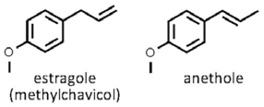 Artemisia dracunculus
Artemisia dracunculus
tarragon • French tarragon • estragon
Back to “Salad herbs and herb mixtures: tarragon, estragon (Artemisia dracunculus)”
Back to “Culinary herbs: estragon, tarragon, French tarragon (Artemisia dracunculus)*; French tarragon, estragon (Artemisia dracunculus)*; tarragon, French tarragon, estragon (Artemisia dracunculus)*”
Artemisia dracunculus L. (Asteraceae); dragon (Afrikaans); tarkhūn (Arabic); estragon (French); Esdragon, Estragon (German); estragon (Italian); estragon (Spanish)
DESCRIPTION The fresh, dried or frozen leaves are narrowly oblong and hairless, with an anise-like aroma and liquorice taste. Russian (false) tarragon is sometimes used as a substitute.1
THE PLANT It is a branched and spreading perennial herb, about 0.2 m (ca. 8 in.) high, with inconspicuous off-white flower heads. Russian tarragon, a cultivar or a separate species (then called A. dracunculoides), is very similar but more robust (and less aromatic).
ORIGIN Southeastern Europe and central Asia. The early culinary history is obscure but the name “tarragon” is derived from tarkhūn, the Arabic name.1 Tarragon only became popular as a salad green and flavouring agent in the 16th century.
CULTIVATION French tarragon rarely produces seeds and is propagated by division or by stem or root cuttings. Commercial production occurs mainly in southern Europe, western Asia and North America. It requires warm, sunny conditions and slightly alkaline, well-drained soils. Plantations are replaced every three years. Russian tarragon is much easier to grow.
HARVESTING The thin leafy stems are harvested twice a year, potentially yielding about 15 tons fresh leaves or 30 kg (66 lbs) essential oil per hectare. Leaves are carefully dried in the shade to retain as much of the flavour (and green colour) as possible.
CULINARY USES Tarragon or estragon is one of the most sought after herbs amongst gourmet chefs because of its delicate anise flavour, reminiscent of liquorice.1 It is one of the four ingredients of the French fines herbes (together with parsley, chervil and chives). Tarragon vinegar is made by steeping a few fresh leafy twigs in a bottle of white wine vinegar. It is an essential ingredient of famous sauces such as béarnaise, hollandaise and tartare that classically accompany asparagus, green beans, peas and other vegetables (as tarragon cream) or chicken, meat and eggs. Leaves (preferably fresh) are used to flavour meat dishes, stews, fish dishes, salads, pickles and mustard sauces. Extracted oleoresin is an ingredient of commercial food products – one part is equivalent to four parts of dried leaves.
FLAVOUR COMPOUNDS Leaves contain essential oil with up to 70% estragole (methylchavicol) as main ingredient, accompanied by several minor volatile constituents.2,3 Estragole is an isomer of trans-anethole and is responsible for the anise flavour. The pungent taste is due to cis-pellitorin (an isobutyramide).4

NOTES Beverages and food items traditionally flavoured with other Artemisia species include absinthe and the original Pernod and pastis (A. absinthium, wormwood or absinth), vermouth (A. pontica, Roman wormwood), beer and herbal teas (A. abrotanum, southernwood) and roasted goose (A. vulgaris, mugwort).
1. Larousse. 1999. The concise Larousse gastronomique. Hamlyn, London.
2. Lopes-Lutz, D.S., Alviano, D.S., Alviano, C.S., Kolodziejczyk, P.P. 2008. Screening of chemical composition, antimicrobial and antioxidant activities of Artemisia essential oils. Phytochemistry 69: 1732–1738.
3. Sayyah, M., Nadjafnia, L., Kamalinejad, M. 2004. Anticonvulsant activity and chemical composition of Artemisia dracunculus L. essential oil. Journal of Ethnopharmacology 94: 283–287.
4. Gatfield, I.L., Ley, J., Foerstner, J., Krammer, G., Machinek, A. 2003. Production of cis-pellitorin and use as a flavoring. Patent: WO04/000787/ PCT/EP03/06545.